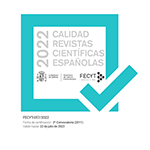Annual weedy species of Erigeron in the northern Iberian Peninsula: a review
Abstract
A revision of the alien Erigeron L. species formerly included in Conyza Less. found in the central-northern Iberian Peninsula is presented. A close examination of numerous specimens collected by the authors as well as voucher specimens preserved at several herbaria has helped clarify several aspects regarding this group. Four species have been recognised in the study area: Erigeron canadensis (=Conyza canadensis), E. bonariensis (=C. bonariensis), E. sumatrensis (=C. sumatrensis) and E. floribundus (=C. floribunda, including C. bilbaoana). They occupy anthropogenic habitats, such as road edges, abandoned fields, crops and waste ground, as well as natural and semi-natural communities, such as nitrophilous river bar communities and ruderal communities on coastal dunes subjected to substantial levels of anthropogenic disturbance. Erigeron sumatrensis and E. floribundus emerge as the two most frequent taxa. Erigeron canadensis, regarded in the past as the most widespread species of the group, is almost absent from the study area, especially from the Atlantic watershed. Furthermore, an important number of specimens previously identified as E. bonariensis do actually correspond to E. sumatrensis. No hybrids have been found. A detailed identification key highlighting the main features that help to separate the four Erigeron species is presented. Finally, as E. floribundus is the most controversial species in the group and the last to arrive, a study of its expansion across western Europe in the last century is included, where it has become a frequent alien especially along the Atlantic regions.
Downloads
Article download
License
Mediterranean Botany is an open access journal to promote global exchange knowledge. It facilitates unrestricted access to its contents from the moment of publication in its electronic edition. The originals published are property of the Universidad Complutense and it is mandatory to cite such source in case of total or partial reproduction. All contents are distributed under a Creative Commons License 4.0 (CC BY 4.0). This circumstance must be expressly stated in this way when necessary. You can check the informative version and legal text of the license.














